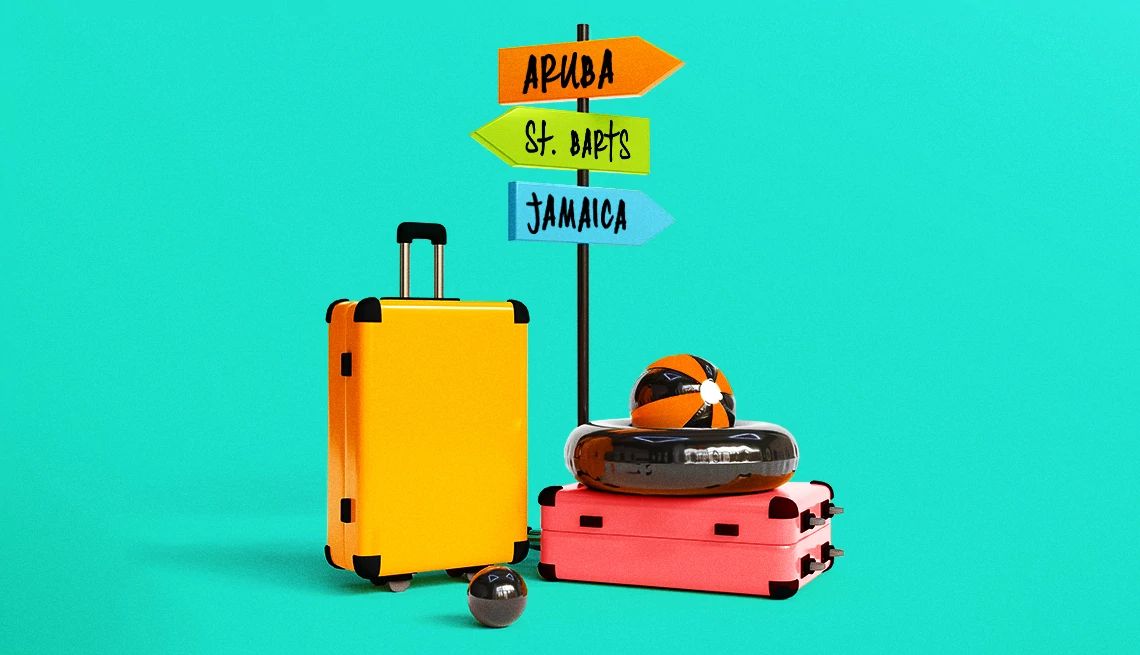AARP Hearing Center


Sunshine and warm weather, combined with full-service resorts, relaxing sandy beaches, calm waters and a laid-back lifestyle, have made the Caribbean a go-to vacation destination for generations.
The Caribbean is one of the literal hot spots for the 55-and-over traveler, with most islands reporting this age group to be their top visitor demographic. In the Dominican Republic, more than half of all visitors are 55 and over, with at least three other islands at nearly 50 percent of travelers.
But which island is right for you? With 28 unique island countries and territories in the Caribbean (and many additional islands within these territories), deciding which one to pick to visit can be a challenge.
Over the past 30 years, I’ve visited more than 15 Caribbean territories and many more islands within them, spending my time hiking, biking and driving across them and swimming, diving, fishing and sailing between them. I’ve sampled more than my fair share of local rums, snacked on conch fritters and johnnycakes, dined on fine bouillabaisse in colonial chateaus and jerk chicken fresh from streetside grills. Experiencing islands from the perspective of a budget backpacker, as well as splurging for five-star resorts, has given me a good feel for the “vibe” of various islands. It’s also given me a sense of what I like about each of them, and can recommend to others. Most importantly, it makes me realize how much I still have to explore and discover in this fascinating region, inspiring me and hopefully you for further adventures.
To help with your Caribbean vacation planning, AARP has put together a guide to choosing between many attractive destinations — whether you’re just visiting a single island or picking among cruise itineraries with multiple stops.
Based on criteria of safety, luxury, affordability, island culture, ecotourism and two-for-one experiences, AARP has selected islands that might best fit travelers targeting each of those qualities.
While opinions on which destination is “best” can be as numerous as grains of sand on an island beach, we hope this guide (with prices in U.S. dollars) gives you a good starting point to help make your dream Caribbean vacation come true.
Sun, sand and safety: Best islands where you’ll feel secure
The Caribbean is overall a very safe region to visit, with many islands rated the safest level of “1” on the U.S. Department of State Travel Advisory Map.
But don’t necessarily skip visiting an island, even if it temporarily has an elevated advisory level of “2” or “3,” like the Bahamas or Jamaica. These advisories usually come with the caveat that “tourist areas generally see lower rates of violent crime than other parts of the country, ” according to the State Department. In fact, the Jamaican Constabulary Force has reported only a 0.01 percent crime rate against tourists, a 10 in 100,000 occurrence. Still, on islands with an elevated caution level, take particular care about where you travel. Within the bubble of an all-inclusive resort or well-monitored tourist locations, you’ll probably be fine. But travel to certain neighborhoods or outlying areas should be skipped or done only with expert advice.
Even for those islands with the highest safety level, visitors should take State Department advice to “exercise normal precautions” while on vacation. This includes being aware of your surroundings, carrying valid international health and travel insurance, and heeding local tips about where to go at night — nowhere has a zero-crime rate.


Aruba
Walking along Aruba’s Eagle Beach and Palm Beach under the shade of palm trees, with calm blue Caribbean waters on one side and a lineup of luxury hotels like the Ritz-Carlton and St. Regis on the other, it’s easy to feel secure. Even at night, walking inland a block or two to a long, well-lit strip of both upscale and affordable shops, restaurants and bars, the vibe is lively and welcoming. At the capital and cruise ship port of Oranjestad further down the west coast, tourists stroll past knickknack shops without a care in the world — for good reason: Aruba is consistently ranked as one of the safest destinations in the Caribbean.
Aruba’s dependence on the tourism sector (composing more than 70 percent of its economy — the second highest in the world, according to the World Travel and Tourism Council) means the island has focused significant resources on the safety and well-being of its visitors. The island’s small size of only 70 square miles (about the size of Washington, D.C.) and limited population of about 108,000 makes safety management easier than on larger islands.
The Radisson Blu Aruba, an oasis of calm two blocks from the lively Palm Beach scene, ranks safety along with scenery as a choice point for the island and the hotel. “Our guests regularly tell us how safe they feel wherever they go around Aruba. There’s a reason why they call it ‘One Happy Island.’ It has long been a very safe and welcoming place for travelers, with low crime rates,” says Luigi Wix, general manager of the Radisson.
In fact, on a recent trip to Aruba, I accidentally left my backpack (with my wallet inside!) on the ground by the parking lot at a popular tourist spot. When I returned in a panic 30 minutes later, the backpack still sat there, undisturbed. While it’s not recommended to leave your valuables sitting out in any destination, this incident serves as an unintentional proof point about Aruba’s safety and consideration by both visitors and locals.
Aruba’s health and hygiene are also rated highly, with quality medical care available and water that’s safe to drink out of the tap, among the cleanest in the world.
Aruba’s bonus safety factor is that the island is far enough south in the Caribbean that it lies outside the hurricane belt, so you’re considerably safer during the peak hurricane season of June through November.
Also recommended:
While the Cayman Islands is famous as a safe place to put your money as a tax haven, the island is safe for visitors as well, with extremely low crime rates. The biggest hazard on the island is probably remembering to drive on the left side of the road (and watching for traffic in that direction).
Anguilla is ranked No. 1 as the safest Caribbean island on The Travel’s statistical list, and this British Overseas Territory is even proper enough to remind visitors to cover up that swimwear and “please shop with your clothes on. ”







































































You Might Also Like
25 Great Ways to Make Your Layover Fantastic
Whether you leave the airport or stay, there’s more to do than patiently wait for your next flight
13 Annoying Airline Passengers You Never Want to Fly With
Buckle up, pack your patience and don’t be one of these types of travelers
25 Great Ways to Upgrade Your Vacation for Less
Small enhancements can make a trip feel even more special